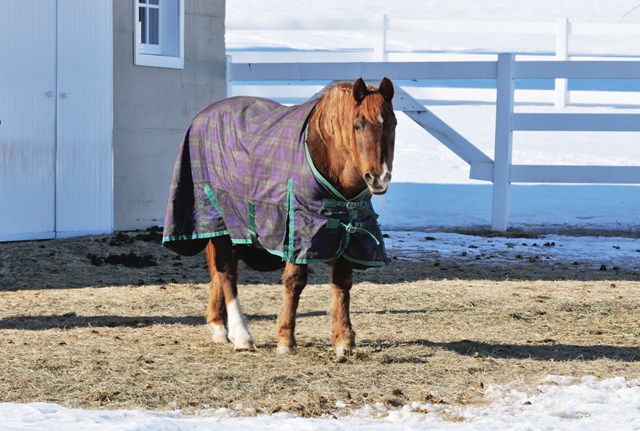By Matt McMillan, Ph.D., Equine Nutritionist, Hi-Pro Feeds
As winter weather approaches, temperatures will begin to fall with the possibilities of rain, snow, ice, and wind. Because of these environmental changes, increased management will be necessary to maintain the well-being and overall general health of horses through increased feeding practices, as well as making certain that proper shelter is provided.
As with all mammals, horses must maintain their body temperatures to survive. This is generally accomplished through consumption of feed and forage to produce energy for the body to perform daily functions such as metabolism, locomotion, and maintenance of body heat. The environmental temperature and heat produced by the body determine how much heat must be conserved by the horse. When the horse is within its thermal comfort zone, the body does little to regulate heat generation and heat loss. In other words, when the outdoor temperature is above a certain point, the horse produces more heat than is needed to maintain its core body temperature. Therefore, energy in the body is used for other things such as digestion, growth, tissue turnover and maintenance, gestation, lactation, walking, galloping, etc.
The thermal comfort zone is unique to all horses because there are several factors that determine what the comfort zone shall be. The lower threshold of the thermal comfort zone is referred to as the lower critical temperature. The lower critical temperature for the horse can be defined as the lowest environmental outdoor temperature that the horse can generally tolerate before increased energy needs or shelter is required. Factors that affect the lower critical temperature of the individual mature horse include but are not limited to temperature, precipitation, wind speed, hair coat length, and shelter.
Mature horses weighing approximately 1,000 lbs found in the Southern United States with moderate body condition scores will reach their lower critical temperature between 30° and 60°F given that there is little to no precipitation and wind less than five miles/hour. Specifically, horses with wet or short hair coats will reach their lower critical temperature at ~60°F. Horses with moderate to heavy hair coats will reach their lower critical temperature at ~50° to ~30°F respectively. When these thresholds are met, individual energy needs will increase by 1% for every 1°F below the critical temperature point. Therefore, during winter weather, if wind-chill causes the effect of the outdoor temperature to feel like 20°F, given the horse has a heavy winter coat and a lower critical temperature of 30°F, then the horse will have an increased energy requirement of ~10% or 2 Mcal/day. If wind speed reaches 15 miles per hour, ~20 -~40% or 4 to 8 Mcal/d will be required in additional energy given that there is no precipitation. If wind conditions are mild but precipitation occurs, ~30% or 6 Mcal/day increased energy will be required. Finally, if wind and precipitation are both present at 30°F, energy needs will increase by ~50% – ~70% or 10 – 14 Mcal/day.
 Proper shelter is one way to protect the horse from reaching a lower critical temperature by reducing or alleviating the effects of wind and precipitation. If sheds are to be placed in pastures or paddocks, it is important that they are secure and safe for all horses. Barns and stalls are also good options to keeping horses warm, dry, and safe. However, if horses are to be kept in barns with short hair coats, it should be recognized that lower critical temperature points will be much higher for these types of horses and should be considered when these horses are turned out.
Proper shelter is one way to protect the horse from reaching a lower critical temperature by reducing or alleviating the effects of wind and precipitation. If sheds are to be placed in pastures or paddocks, it is important that they are secure and safe for all horses. Barns and stalls are also good options to keeping horses warm, dry, and safe. However, if horses are to be kept in barns with short hair coats, it should be recognized that lower critical temperature points will be much higher for these types of horses and should be considered when these horses are turned out.
Feeding horses properly in winter conditions may require some management adjustments compared to other times of the year. It is widely accepted that increasing forage in colder weather is a good management practice due to the increased heat value as compared to feeding additional grain. The reason for this is due to the bacterial fermentation process that takes place in the cecum and large intestine that creates more heat to provide warmth to the body of the horse.
Alfa-Pro® is a product provided by Hi-Pro Feeds that is a chopped alfalfa hay cube that is fortified with all the necessary vitamins and minerals for the horse to meet all its nutrient requirements under most circumstances. Alfa-Pro can be fed as a complete feed where horses can consume anywhere from 15 to 25 lbs per day based on stage of life and level of activity. Further, Alfa-Pro contains ~1 Mcal/lb so for every 10% increase in energy needs caused by cold, wet, windy weather, an additional 2 lbs of Alfa-Pro can be fed to meet the necessary requirements. For more information on Alfa-Pro and other quality equine products click here.

